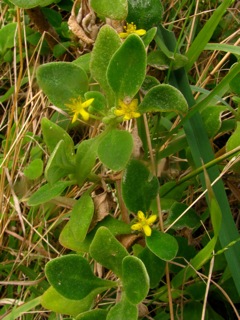Our heavy winter rains look to be setting us up for a great spring flower display.
The wattles have been giving us lovely colour in the bleak winter weather, and here are some to look out for this month. I always think that the most spectacular is Golden Wattle Acacia pycnantha. Its rich clusters of golden balls contrast so well with the long, dark-green phyllodes. It is very widespread in our area, so much so that there is concern that it is taking over in some places.

Golden Wattle
Less showy are the cream balls of Blackwood Acacia melanoxylon. Another very common wattle, Prickly Moses Acacia verticillata subsp. ovoidea and subsp. verticillata, has globular or cylindrical spikes.

Prickly Moses
I found more yellow when walking on the clifftops. A strong sweet scent wafted my way and, looking around, I saw the small, yellow, four-petalled, flowers on the aptly named Bower Spinach Tetragonia implexicoma. I just love the way this plant drapes itself over any available foliage. In my search for a sensory plant for this month I discovered that the succulent leaves are worth feeling as they have an interesting rough texture.

Bower Spinach
August is a great month for looking for flowers on the fascinating carnivorous Sundews Droseras. I always love to see the ground- hugging single white flowers just above the red, glistening rosettes of leaves of the Scented Sundew Drosera whittakeri subsp. aberrans. However, they are often hard to find as they may only flower after being burned. If you have never smelt one then I recommend getting down to ground level to experience their delightful fragrance. The two most common upright Sundews, Tall D. peltata subsp. auriculata and Climbing D. macrantha subsp. macrantha have small white to pink flowers. It is worth a closer look at the leaves for insects trapped by the sticky hairs.

Scented Sundew

Climbing Sundew
I am looking forward to seeing the creamy, starry flowers open on my male and female Small-leaved Clematis C. Microphylla which grow near my back door. The male plant is usually first and, once it has released its pollen, the flowers soon wither. In contrast, the female flowers start a bit later and then, after fertilisation, alter quite dramatically over time till the flowers look like their other common name ‘Old Man’s Beard’! I am less keen on them at this stage as the numerous seeds blow into my house. This plant is a vigorous grower and can be seen draping itself over plants and trees in great floral displays.
Be on the lookout for two small and delightful white plants, the upright Creamy Candles Stackhousia monoyna, and the tiny, starry Early Nancy Wurmbia dioica subsp. dioica. Flowers of Anglesea and Aireys Inlet shows clearly the difference in the male and female flowers on the Early Nancy. This book is really useful in identifying the many flowers which will be emerging this month. I can’t wait to see what flowers will appear!
Ellinor Campbell